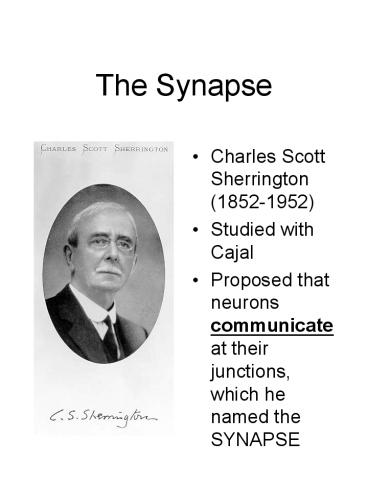The Synapse
1 / 17
Title: The Synapse
1
The Synapse
- Charles Scott Sherrington (1852-1952)
- Studied with Cajal
- Proposed that neurons communicate at their
junctions, which he named the SYNAPSE
2
The Synapse
- How did Sherrington learn about the synapse?
- Did he mostly study the BRAIN or BEHAVIOR?
- He studied the REFLEX
- Stimulation to skin --gt muscle movement
- Brain not necessary
3
The Synapse
Whats missing?
4
The Synapse
- Sherrington might pinch the foot of a dog
- Dog raised that foot, and extended others?
- What happened when he cut the spinal connection
from this reflex arc to the brain? - What about the reflex arc helped him understand
how the synapse operates?
5
The Synapse
- Does the action potential travel across the
synapse? - How might you be able to tell?
- What if multiple inputs to the reflex arc occur
(suppose you could pinch 3 or 4 places on the
dogs foot)? Does each cause the same reflex? - How could you test it?
6
The Synapse
- One test if the action potential travels across
the synapse, then the time from A to B should
relate how to the time from C to D
7
The Synapse
- Another test if multiple reflex arcs are
simulated, what kind of response occurs?
8
The Synapse
- Answer to 1 if the time from A to B is NOT the
same as from C to D, we can infer that the action
potential does not travel across the synapse, but
some other kind of communication occurs - Answer to 2 the second case occurs. This means
the inputs are SUMMED
9
The Synapse
- What is information in the brain?
- Inputs are summed.
- What does summed mean?
- Summed in intensity?
- Summed in time?
- How does time vary?
- Inputs
- Output
10
The Synapse
- Sherrington also observed that as the dogs foot
is pinched and some muscles are excited, others
relax - What is information?
- A balance between competing information flows
- Examples at higher levels?
- Humans have GREATER CONTROL
- What part of the brain do they use?
11
The Synapse
- What about the system Sherrington studied allowed
him to infer so much about neuron behavior,
without seeing or touching specific neurons? - Anatomy of the system
- A perfect laboratory
- Input neuron, interneuron, ouput neuron
12
The Synapse
- Communication across a synapse is different than
communication along a neuron - A single pinch might not always cause the reflex
to happen THRESHOLD - Temporal summation of multiple stimuli
- In temporal summation, time matters
- The time between stimuli tells us several things
13
The Synapse
- The input decays
- How fast it decays
- The inputs must be more rapid than the decay rate
to summate - Remember spike trains and information?
- Remember depolarization?
- John Eccles later confirmed Sherringtons
findings with electrodes in cells measuring
changes in potentials (electrical stimulation and
recording)
14
The Synapse
- Graded potential
- Not all or nothing like an action potential
- Positive (depolarization)
- Negative (hyperpolarization)
- What is mechanism?
- What elements are involed?
15
The Synapse
- EPSP excitatory postsynaptic potential (positive
change, depolarization) - What IONS? Sodium ions move INTO the cell
16
The Synapse
- Magnitude decreases
- Across time
- Across space
- Information?
- (illustrate next slide)
- Summation, competition and timing
17
Spatial and Temporal summation































